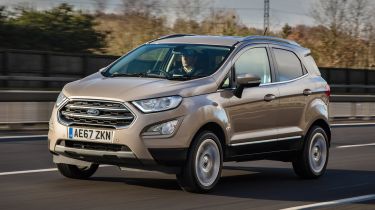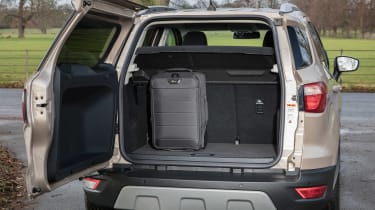Ford EcoSport (2014-2023) - Practicality, comfort and boot space
The EcoSport isn't the roomiest choice - it's left trailing for rear passenger space and boot capacity

Just so you know, this is an older review of the 2014-2023 Ford EcoSport. If you are interested in information about a used Ford EcoSport, or news about the latest Ford models, please follow the links provided.
The EcoSport is a crossover based on the Ford Fiesta, with similar dimensions, so Ford's smallest SUV is never going to be the most spacious car. Truth is, it doesn’t need to be, as rival models don’t exactly score on practicality, either. But, the car is still left in the shade by some competitors – the Peugeot 2008 and Renault Captur offer more space.
Size
At just over four metres, the EcoSport is the same length as a Ford Fiesta, so it’s one of the most compact crossovers on the market. Ford used to quote the same measurement when the EcoSport featured its rear-mounted spare wheel, but now this has been taken off the tailgate, you can trust the measurement.
The spare wheel mounting caused controversy when the car was launched, with many people criticising it as old-fashioned and impractical. Ford therefore decided to make it an option on the updated EcoSport, cleaning up the lines around the rear of the car and making it easier to park. Trouble is, it couldn't be combined with the rear-view camera on other trim levels. So, with no option to stow a spare under the boot floor, every model now comes as standard with a tyre inflation kit.
Leg room, head room & passenger space
Cabin space in the EcoSport is about average for the class, but that’s not saying much. After all, rivals in this market include the Nissan Juke, which is notoriously tight in the back. Certainly, the likes of the Peugeot 2008 leave the Ford trailing for rear seat space: rear legroom is particularly tight in the EcoSport, with the result that anybody close to six-foot tall in the back will end up with his or her knees pressed into the seat in front.
Boot
As with passenger space, so with the boot, the EcoSport's capacity of 355 litres is only average – the Renault Captur offers 100 litres more than that (albeit only when you move the sliding rear seats all the way forward), while most competitors provide around 20 litres of extra space with their back seats in their normal position.
The 355-litre boot doesn’t place the EcoSport near the front of the pack on practicality either, beaten by the 400-litre capacity of the SEAT Arona – itself not the most cavernous in class.
It’s not only the size of the boot that lets the EcoSport down, though, as access to the load bay is hampered by the side-hinged rear door. This design just seems needlessly old-fashioned, when every other car in the class uses a more practical top-hinged hatch. Plus it’s hinged on the left-hand side, which obstructs loading if you’re parked with that side of the car next to a pavement.









